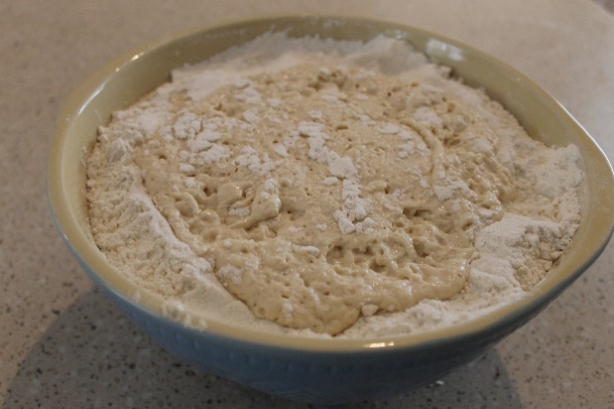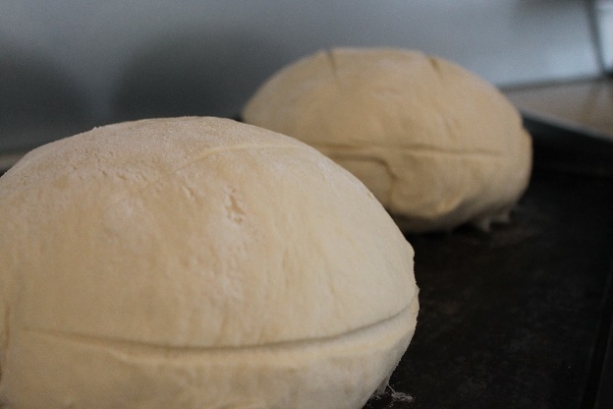Good family bread
Ingredients
- 1400g strong bread flour
- 24g fresh yeast
- 200ml milk, lukewarm
- 525ml water, lukewarm
- 27g salt
Note
This recipe is based on Eliza Acton’s ‘Good Family Bread’ (1857). It makes soft, delicious white bread that is perfect for sandwiches. You do have to add some salt, which has been forgotten in the original recipe.
Directions
|
|
 Place the flour in a large bowl and make a well in the middle.
In another bowl combine the milk, and 160ml of the water. Crumble the yeast onto the liquid and stir well. Pour the liquid mixture into the well of the flour.
Carefully stir some of the flour from the edges of the well into the liquid. Do not try to mix all of the flour and liquid together, just enough to make a thick batter (see images above). Sprinkle some more of the flour on top of the batter, cover the bowl with a tea towel and leave for an hour. |
|
|
 At the end of an hour, the yeast should have risen nicely and have bubbles on the surface.
Sprinkle the salt on top of the batter, and add the rest of the water. Mix everything together to form a ball, then turn it onto a lightly floured surface and begin to knead. Add a little more water to the dough if it’s too dry to come together as a ball.
Knead for 10 minutes, or until the dough passes the windowpane test (can be stretched to be almost see-through without breaking). Place the dough in a clean bowl, cover with a tea towel and leave for 45 minutes. |
|
|
 Pre-heat the oven to 220ºC, with a large baking tray in the oven which the bread will go on, and a deeper tray below that. Boil a kettle of water.
Wet a sharp knife and use it to cut the ball of dough in half. Take each half and gently pull the edges down around the cut edge and pinch the edges at the bottom to form a ball of dough. Try not to manipulate the bread too much because we want to keep as much of the natural gases in the dough as possible. When both loaves are ready, wet the knife again and make a shallow cut all the way around the loaves. Also make one or two cuts across the top of the loaves.
Carefully remove the hot baking tray from the oven and place the loaves of bread on it. Return it to the oven, and pour about a cup of hot water from kettle into the second, deeper tray in order to create a steamy environment for the bread to cook in. Be very careful that you don’t burn yourself with the steam. Close the oven door and bake for 10 minutes, then turn the oven down to 200ºC and continue to bake for another 50-65 minutes. The bread should be well-risen and golden brown, and sound hollow when knocked with your knuckles.
Remove the bread from the oven and turn upside down to cool on wire racks. Wait until they are totally cold before slicing. |
Have you tried this recipe?
Use the comments box below to upload comments and photos.
 Print recipe
Print recipe

